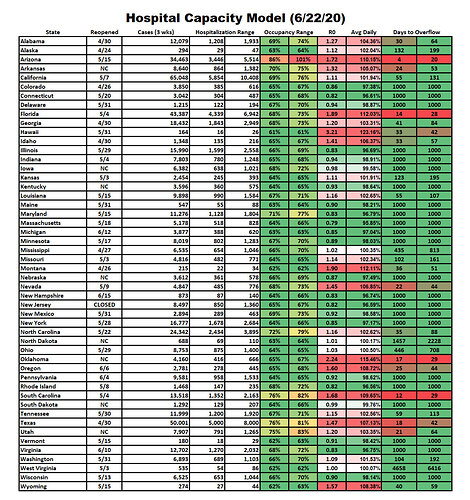States I’ve been watching…
Arizona: No major change, which is a good thing, but I went in and checked and that’s 3.77 rounding up to 4. I’m guessing the 4 yesterday was 4.xx rounding down. I should say that the fact that no major change is a good thing tells you just how fucked they are IMO. They’re on a death march, but they didn’t start into a dead sprint yet.
South Carolina: A slight decrease in R0 buys them a day. Is it noise or the beginning of a trend? Most likely noise, but at least it’s a glimmer of hope for a state that could still avoid the worst case scenario… barely.
Florida: R0 is up to 1.89 from 1.8, days remaining outpace their trend just slightly. Not good. Orlando has an R0 of 4.2, which is absurd. If you go with the rolling 7 days instead of 14, it’s “only” 2.4. The actual number is probably in between. Seems like a good time to point out that the current R0 is dependent on current behaviors, and what we’re really doing here is estimating what the R0 has averaged the last two weeks and assuming it’ll be similar going forward. At R0=4.2, based on their own hospital capacity data as of yesterday (86% full), and based on a low end estimate of 10% of positive tests over the last 21 days currently being hospitalized, they have 3.8 days to full capacity in Orange County (Orlando). If you give them the 2.4 R0, they are 6.2 days away. Keep in mind that on that timeline, the hospitalizations that drive them over the threshold will come from people who were infected at least a few days ago. Orlando is in dire need of surged capacity, either through getting non-covid patients out or adding more beds. Their ICU capacity is at about 75%, but this may even be worse. Keep in mind of the 86% of beds full, only about 1 in 10 of those is COVID. So the 8% keeps growing and when it hits 22% (8+14), that’s when you’ve hit capacity. I’m guessing it’s more like 1 in 3 cases in the ICU that are COVID, but that’s a total guess.
Even if I’m way off on Orlando, they need to hit a parlay: I’m wrong on my assumptions about hospitalization rate AND that R0 is closer to 1 now. Otherwise they need to surge capacity and they still will be in a world of trouble.
Oklahoma: Speaking of dead sprints, their R0 is up to 2.24, so that’s trending in an even worse direction. 17-29 days to tipover, and a week to 10 days away from a bunch of Trump rally covid cases in all likelihood.
Texas: Also picking up speed, up to 1.47 and losing two extra days off the front end and five extra off the back end. It’s unacceptable, and it seems like that’s just going to have to be accepted. (Abbott reference.)
Nevada: Loses one extra day off the front, three extra days off the back, slightly worse R0.
Idaho, Kansas, Montana and Wyoming are in danger of joining this list soon.
Hawaii: Slight improvement, I expect them to make a big leap in the right direction at the end of the week in the Thursday or Friday update.
Oregon: Shout to Oregon, they pretty much ramped it up and shut it back down right before it got to be out of control. They gain a few more days of life, and their R0 dips to 1.60. I expect this trend to continue. This is a pretty good example of reopening, failing to keep the R0 < 1, and course correcting.
Houston only adds 179 new cases today, according to the data I’m seeing. This is Sunday’s data, though, and the Sunday lull seems to be a thing there. As a result, their R0 is essentially unchanged. They are 16 days from overflow, which keeps them on the same track. The bad news is, their tipover date still ticked off one despite an expansion in beds available to COVID-19. I believe they are beginning to scale back non-COVID hospitalizations in order to surge capacity for COVID. You would hope that expansion would push the date out, but no such luck.
Either Abbott’s a complete moron or he knows exactly how far he can scale these capacities and is waiting until the last possible minute to do a shutdown. Either way, with exponential growth at play, a gambling event is occurring in Texas.
